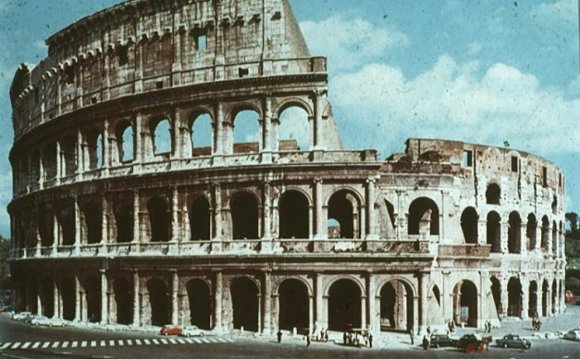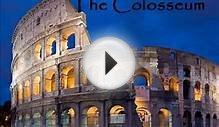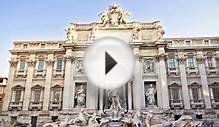
Many European cities still bear reminders of the power of ancient Rome, and throughout the western world the influence of Roman power is still manifest. Architecture was crucial to the success of Rome. Both formal architecture like temples and basilicas and in its utilitarian buildings like bridges and aqueducts played important roles in unifying the empire. The construction of a roads with bridges helped communication across the far flung empire. Aqueducts like the so-called Pont du Gard enabled the Romans to provide adequate water supply to its cities. City walls like the one in Autun in central France protected the Roman cities. Cities provided a network of administrative centers and acted as visible symbols of power throughout the Empire. Many European cities and towns, most notably London and Paris, were founded by the Romans.
The buildings in these cities directly and indirectly served Roman power. A building type known as the basilica served administrative functions. The basilica acted like a town hall or court house in American cities. The so-called Basilica Ulpia constructed by the Emperor Trajan at the beginning of the second century AD can be used to exemplify this category of building. A characteristic element of these basilicas was a projection called an apse which served as the seat of the magistrate responsible for dispensing the law. Accompanying the magistrate would be an image of the Emperor, the source of the law. A sixth century illustration of Christ being judged shows the seated Pontius Pilate flanked by images presumably of the emperor. The semi-circular line above the scene is best explained by seeing this as an echo of the form of the apse. For a citizen of the empire the basilica in a Roman city conveyed the idea of Roman authority. The associations with authority was an important rationale for the use of the basilica type as the standard form of the Christian church from the time of the Emperor Constantine.
Many European cities still have amphitheaters that served as arenas in which the Roman staged spectacles that entertained the population. Gladiatorial contests and even sea battles were staged that imitated great Roman military victories. The most famous and grandest amphitheater was the so-called Colosseum that was begun by the Emperor Vespasian in about 72 AD. It was built on the site of a garden that had been part of the lavish palace the Emperor Nero had created in the center of Rome. The building of the Colosseum was clearly a political statement on the part of Vespasian. It conveyed to the Roman people the overthrow of the hated Nero and Vespasian's interest in appealing to the broad mass of the Roman people.
Triumphal Arches like the Arch of Titus (c. 81 AD, Rome (left)) or the Arch of Trajan (114-117 AD, Benevento (right)) were constructed by Emperors in Rome and its major cities to commemorate great military triumphs. They thus gave clear testament to the great military power of Rome.
The foundation of temples was particularly important to Emperors. Religion and politics were very much allied in the Roman world. The public cults celebrated outside these temples were a significant way the population attested to their membership to the community and to the Empire. The building of a temple by an emperor was a clear testament of his pietas, or his dedication to the traditional customs of Roman society. The Maison Carrée from the southern French town of Nîmes is a particularly well-preserved example of a Roman Temple. Roman temples, while related to the Greek temple form in general design and use of the Classical orders, represent a very defined category of temple form. The distinctive elements of being raised on a podium, having a front staircase, and having the columns along the sides being attached or engaged (pseudo-peripteral) allow for the easy identification of a Roman temple. For a Roman citizen from Syria to England, the appearance of this form of temple and the cult practices associated with it provided a sense of membership in the empire.
RELATED VIDEO




 Italy /ˈɪtəli/ (Italian: Italia [iˈtaːlja]), officially the Italian Republic (Italian: Repubblica italiana), is a unitary parliamentary republic in south-central Europe. To the north, it borders France, Switzerland, Austria and Slovenia along the Alps. To the south...
Italy /ˈɪtəli/ (Italian: Italia [iˈtaːlja]), officially the Italian Republic (Italian: Repubblica italiana), is a unitary parliamentary republic in south-central Europe. To the north, it borders France, Switzerland, Austria and Slovenia along the Alps. To the south...
 Islam (English /ˈɪzlɑːm/; Arabic: الإسلام al-ʾislām IPA: [ʔɪsˈlæːm] ( listen)) is a monotheistic and Abrahamic religion articulated by the Qur'an, a text considered by its adherents to be the verbatim word of God (Arabic: الله Allāh), and by the teachings and...
Islam (English /ˈɪzlɑːm/; Arabic: الإسلام al-ʾislām IPA: [ʔɪsˈlæːm] ( listen)) is a monotheistic and Abrahamic religion articulated by the Qur'an, a text considered by its adherents to be the verbatim word of God (Arabic: الله Allāh), and by the teachings and...








